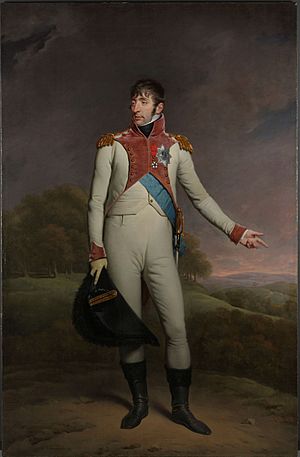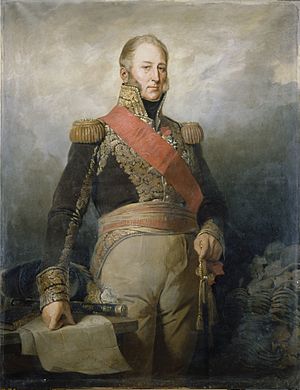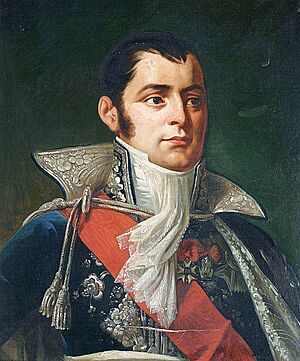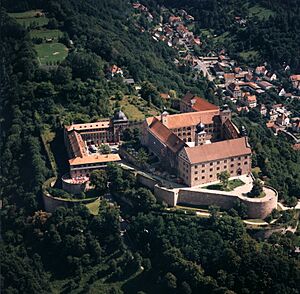Siege of Hamelin facts for kids
Quick facts for kids Siege of Hamelin |
|||||||
|---|---|---|---|---|---|---|---|
| Part of The War of the Fourth Coalition | |||||||
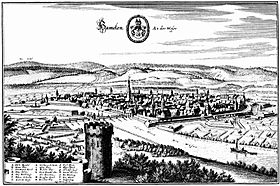 Hamelin, showing the town's defences in 1654 |
|||||||
|
|||||||
| Belligerents | |||||||
| Commanders and leaders | |||||||
| Units involved | |||||||
| VIII Corps | Garrison of Hamelin | ||||||
| Strength | |||||||
| 6,000 12 cannons |
10,000 175 cannons |
||||||
| Casualties and losses | |||||||
| minor | 600–10,000 175 guns |
||||||
The Siege of Hamelin was a military event that took place from November 7 to November 22, 1806. During this time, forces from the First French Empire and the Kingdom of Holland captured the fortress of Hamelin. The Prussian army had been defending the fortress.
The siege was part of the War of the Fourth Coalition. This war involved France and its allies against several European powers. French Marshal Édouard Adolphe Casimir Joseph Mortier started the operation. General Jean-Baptiste Dumonceau was in charge at first. Later, General Anne Jean Marie René Savary arrived and talked to the Prussian commander, General Karl Ludwig von Lecoq. General Lecoq soon agreed to surrender.
Hamelin is a city located about 36 kilometers southwest of Hanover. This event was more like a blockade than a full siege. A blockade means surrounding a place to cut off supplies and force a surrender.
After Emperor Napoleon I won a major victory against the Prussian armies at the Battle of Jena-Auerstedt on October 14, his army chased them. This left the Prussian forces defending the area of Electorate of Hanover isolated. While the main French army pursued other Prussian forces, smaller French armies moved into Hanover and Hesse-Kassel. The Prussian defenders in these areas went into fortresses like Hamelin and Nienburg. They were then blockaded and captured.
Contents
How the Siege of Hamelin Began
In September 1806, King Frederick William III of Prussia prepared his armies for war. A large group of soldiers gathered near the area of Hanover. Lieutenant General Gebhard von Blücher had about 16 infantry battalions and 17 cavalry squadrons. These forces were located in western cities like Paderborn and Osnabrück.
In Hanover itself, there were 20 battalions and 28 squadrons. These were in places like Celle and Hildesheim. This group became the westernmost army, with about 30,000 soldiers. General Ernst von Rüchel and Blücher led these troops.
Prussian Plans and French Counter-Moves
The Prussian leaders knew Napoleon would attack from the south. So, their western army marched towards Erfurt in early October. General-Major Christian Alexander von Hagken and General-Major Karl Friedrich von Brüsewitz stayed behind. Their job was to defend against a French attack from the Kingdom of Holland and the lower Rhine River.
Including the soldiers in Hamelin and Nienburg, Prussia had about 12,000 troops in this region. Smaller mobile groups were put together near Münster. General Karl Ludwig von Lecoq was in command of these forces.
The French forces were led by King Louis Bonaparte in Holland and Marshal Édouard Adolphe Casimir Joseph Mortier at Mainz. King Louis had two divisions, each with about 5,000 to 6,000 soldiers. Marshal Mortier's forces were also ready. Napoleon's plan was to keep these French forces in place. Once he defeated the main Prussian army, they would then capture Hesse-Kassel and Hanover.
Military Actions Leading to the Siege
On October 9, General Lecoq and General Hagken began moving west. Their march was slow. On October 19, the Prussians heard about their huge defeat at Jena-Auerstedt. Lecoq and Hagken immediately retreated to Hamelin, arriving on October 23.
From Hamelin, Lecoq tried to reach the Elbe River the next day. However, he heard that French forces were blocking his way. He stopped his march on October 27 and returned to Hamelin. There, he started gathering food and supplies to prepare for a siege. He sent Colonel Christian Friedrich von der Osten with some soldiers across the Elbe. They joined part of Blücher's army.
After the Battle of Jena-Auerstedt, General-Major Karl Anton Ernst von Bila left Hanover on October 20. He took one battalion, the treasury, and important documents with him. He safely crossed the Elbe. However, his small force was caught by the French after the Capitulation of Stettin. He and his brother, General-Major Rudolf Ernst Christoph von Bila, surrendered with 2,200 troops on November 1.
French Advance into Hanover
On October 17, Napoleon gave orders to King Louis and Marshal Mortier. King Louis was to capture Paderborn and Münster. Marshal Mortier was to take Fulda and connect with General Henri Jacques Guillaume Clarke at Erfurt. Once they were in position, Napoleon wanted them to meet at Kassel. Their goal was to take over the state of Hesse-Kassel. Even though William I, Elector of Hesse said he was neutral, Napoleon knew he was against France. So, Napoleon decided to remove him from power.
Marshal Mortier's army, called the VIII Corps, included General Louis Henri Loison's infantry division. This force had 5,500 soldiers and was made up of three light infantry regiments. On November 1, Mortier's army entered Kassel from the south. King Louis's troops arrived from the north soon after. The Hessian soldiers were disarmed without a fight. The French then announced that Hesse was now part of their empire. The Elector and his son managed to escape.
King Louis left the army on November 9, saying he was sick. Mortier then took command of both forces. On November 7, the first French troops reached the edge of Hamelin. More French soldiers arrived on November 10.
The Siege of Hamelin
Marshal Mortier left General Dumonceau with 6,000 men and 12 cannons to blockade Hamelin. Mortier himself continued to the city of Hanover, which he captured on November 12. General Dumonceau's Dutch Division had four brigades. These brigades included various infantry and cavalry regiments.
General Lecoq commanded about 10,000 Prussian troops and 175 cannons inside Hamelin. The garrison, led by General-Major von Schöler, had 3,058 men. This included several infantry battalions. Lecoq's force also had gunners, hussars, and about 1,000 refugees from the Jena-Auerstedt battle. The fortress had plenty of food and ammunition.
Mortier kept putting pressure on Lecoq to surrender. At first, the Prussian general refused. Meanwhile, Napoleon was trying to make a peace agreement with Girolamo Lucchesini, the ambassador from King Frederick William III. One idea in this agreement was for all Prussian fortresses to surrender. Even though the ambassador approved it, the King later rejected it.
However, Napoleon sent General Savary to Hamelin. Savary's goal was to use this information to convince the Hamelin garrison to surrender. Savary arrived on November 19 and met with Lecoq and his generals. The French general reminded them that there were no other Prussian forces within 400 kilometers. Then, he revealed the peace agreement that had been made with Lucchesini.
Even though Lecoq's forces outnumbered the French almost two to one, he agreed to surrender the next day. The terms were similar to the surrender of Prenzlau. This meant that the officers would be released on their word, but the regular soldiers would become prisoners of war.
The Surrender and Its Aftermath
The surrender happened on November 22. There are two different stories about what happened.
In one version, when the Prussian soldiers found out about the surrender, they rebelled. They rioted in the streets, robbing and shooting at the people of Hamelin and each other. The officers demanded that the soldiers be sent home instead of becoming prisoners. To enforce the surrender terms, Savary sent his cavalry into the streets. The horsemen gathered the Prussian soldiers outside the city. There, they were surrounded and disarmed.
In the second version, only 600 Prussians were captured. The rest of the garrison, about 9,000 men, escaped from Hamelin during the confusion of the mutiny. They scattered into the countryside.
Outcomes of the Siege
After Hamelin, General Savary led Dumonceau's division to Nienburg. Nienburg was already being blockaded by a small French force. General-Major von Christian Georg Ludwig Strachwitz commanded the 2,911-man Prussian garrison there. On November 26, the Nienburg garrison also surrendered. The officers were released on their word. Non-commissioned officers and married men were allowed to go home. Soldiers from Westphalia were sent to Minden and released. Only a few were sent to France as prisoners.
A few days before these surrenders, on November 25, the strong fortress of Plassenburg also surrendered without a fight. This fortress, near Hof, had been surrounded by Bavarian forces since October 11. The garrison of 629 soldiers, led by General-Major von Johann Adam Siegmund Uttenhoven, gave up.
Historians have different views on Lecoq's surrender at Hamelin. Historian Francis Loraine Petre believed Lecoq should have held out longer. His quick surrender made it easier for Napoleon to send his troops to other campaigns. Digby Smith called the Hamelin surrender "shameful."
A few days before the final surrenders, on November 16, Napoleon released a statement. He claimed that out of 145,000 Prussian and Saxon soldiers, only a few leaders escaped. Historians note that for once, Napoleon's statement was not a huge exaggeration. Hundreds of captured horses were used to equip the French cavalry. Besides the huge loss of soldiers and horses, the Prussians lost many cannons and other military equipment.
For surrendering Hamelin, General Lecoq was sentenced to life imprisonment in December 1809. However, he was allowed to spend most of his time in the city of Spandau instead of a prison. He was even allowed to visit his home in 1812. From 1813, he could live in Oranienburg, and in 1814, he received a pardon. Lecoq was a talented mapmaker and continued to make maps until he became blind. He died in 1829.


